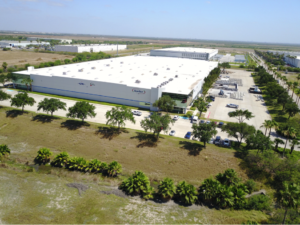Food irradiation marketed to fresh produce market
By Stephen Kloosterman, contributing editor
Although not used widely throughout the processing industry, food irradiation technology has been around for more than 50 years as a way to kill pathogens.
Now, a growing firm called ScanTech Sciences is marketing its irradiation services for use with fresh produce.
ScanTech Sciences is building its first facility in McAllen, Texas’ Rio Grande Valley ECP Center, and it’s scheduled to open for commercial operations during the summer of 2018.
The facility will be able to process between 120-160 cases of produce per minute, said Lindsay Eierman, ScanTech Sciences’ marketing manager. The company plans to open other facilities in ports of entry, such as New York/New Jersey and Nogales, Arizona, she said. Eventually, the company’s plans are to expand to areas such as of secondary import and export markets, such as Savannah, Georgia; Houston, Texas; and California.
Food irradiation is approved by dozens of reputable organizations, including the U.S. Department of Agriculture, the Food and Drug Administration, the Centers for Disease Control, the American Medical Association, and the United Nations World Health Organization, Eierman said — it’s also currently used as a postharvest food process in over 40 countries.
But there is room for the process to grow.
“There are two primary reasons that food irradiation is not more widely used,” Eierman said. “The first issue is intellectual property and investment. The technology is very complicated and requires expertise in nuclear engineering, mechanical engineering, and food science.”
Food irradiation can include the use of gamma rays, X-rays or electron beams, called e-beams. ScanTech Sciences’ patented form of e-beam food irradiation is Electronic Cold-Pasteurization, so-called because it allows product to be kept cold throughout the process. Not breaking the cold chain of storage is an added value for food processors.
The second reason food irradiation is uncommon, she said, is simply capacity. The technology is expensive, and Eierman said there have not been very many successful food irradiation ventures.
Eierman said food irradiation could be a good fit for processing fresh produce.
“Electronic Cold Pasteurization is a great solution for fruit, vegetables, herbs, spices and ready-to-eat (fresh-cut) commodities such as sliced apples,” she said. “It is particularly beneficial for commodities with short shelf life (such as berries or leafy greens), commodities with a high incidence of pests (such as peaches, which have the plum curculio), and commodities that are susceptible to contamination with pathogens (such as Listeria monocytogenes in cantaloupe or E. coli in lettuce).”
For more on ScanTech Sciences read the full story in the upcoming July/ August edition of Produce Processing.







